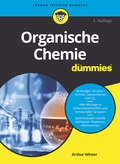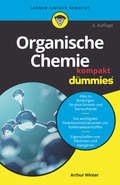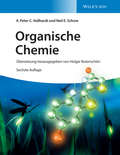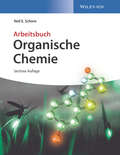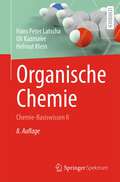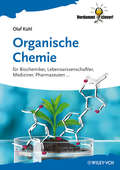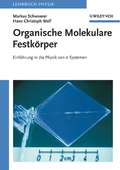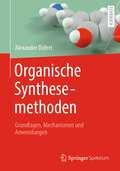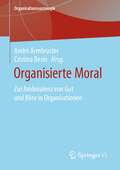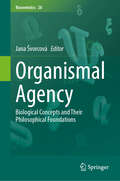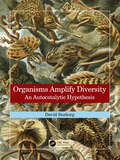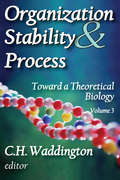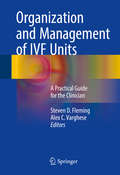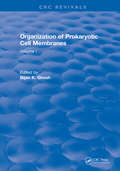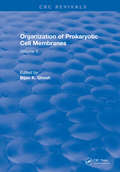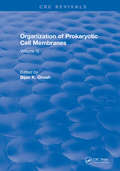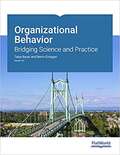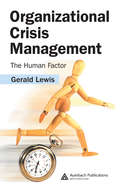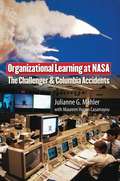- Table View
- List View
Organische Chemie für Dummies (Für Dummies)
by Arthur WinterMan könnte meinen, dass eine Wissenschaft, die sich hauptsächlich mit Verbindungen eines einzigen Elements auseinandersetzt, vergleichsweise übersichtlich ist. Doch Kohlenstoff ist ein ganz besonderes Element, denn Kohlenstoffverbindungen bilden die Grundlagen des Lebens. "Organische Chemie für Dummies" führt Sie in die Geheimnisse der organischen Verbindungen ein, erklärt Ihnen die Grundlagen der Spektrometrie und Spektroskopie, zeigt Ihnen, welche Reaktionen möglich und welche unmöglich sind und vieles mehr. Nach jedem Kapitel finden Sie Übungsaufgaben mit ausführlichen Lösungen. So unterstützt Sie das Buch bei Ihrem Einstieg in die Organische Chemie.
Organische Chemie für Dummies (Für Dummies)
by Arthur WinterHier dreht sich alles um Kohlenstoff Wie die Zusammenhänge und Konzepte der organischen Chemie funktionieren, lernen Sie in diesem Buch. Arthur Winter erklärt Ihnen, was Sie über Kohlenstoffverbindungen, funktionelle Gruppen und Reaktionsmechanismen wissen sollten. So erfahren Sie, welche Reaktionen möglich und welche unmöglich sind. Außerdem vermittelt er leicht verständlich auch komplexe Themen wie die Stereochemie und die Spektroskopie. Zu jedem Kapitel gibt es Übungsaufgaben und ausführlichen Lösungen. So unterstützt Sie das Buch nicht nur theoretisch, sondern auch praktisch bei Ihrem Einstieg in die Organische Chemie. Sie erfahren Wie Sie organische Strukturen korrekt zeichnen Wie Sie Reaktionsmechanismen erarbeiten Was Sie über Säuren, Basen und den pKs-Wert wissen sollten Welche Fachbegriffe Sie kennen müssen
Organische Chemie kompakt für Dummies (Für Dummies)
by Arthur WinterIn der Schule und beim Studium der Naturwissenschaften kommen Sie an der Organischen Chemie nicht vorbei. Doch dieses Buch hilft Ihnen, wenn Sie sich einen schnellen Überblick über dieses komplexe Thema verschaffen wollen. Arthur Winter erklärt Ihnen leicht verständlich, was Sie über Kohlenstoffverbindungen, funktionelle Gruppen und organische Reaktionen unbedingt wissen sollten. So ist dies Ihr perfekter Nachhilfelehrer für die Tasche: freundlich, kompetent, günstig.
Organische Chemie: Arbeitsbuch (Wiley-vch-lehrbuchkollektion 1 Ser.)
by Neil E. Schore K. Peter VollhardtEndlich - die 6. Auflage des bewährten "Vollhardt/Schore" ist da! Neu und modern gestaltet vermittelt das Lehrbuch verständlich und übersichtlich das Wissen der organischen Chemie. Der komplette Text wurde überarbeitet, aktualisiert und erweitert. Im Mittelpunkt des seit Jahrzehnten erfolgreichen Lehrbuchs stehen das Verständnis von Reaktionen, Strukturen, Mechanismen und Synthesen - das Fundament der organischen Chemie. Neu: Lernziele am Anfang des Kapitels geben einen praktischen Leitfaden über den Lernstoff eines jeden Kapitels Neu: die Rubrik "Wirklich?" nennt überraschende und ungewöhnliche Fakten Neu: "Wir fassen zusammen" - eine hilfreiche und kurze Zusammenfassung am Ende eines jeden Teilkapitels Neu: zusätzliche erklärende Kommentare erläutern detailliert die ablaufenden Reaktionsmechanismen - über 1600 Seiten prall gefüllt mit dem Wissen über die organische Chemie zu einem unschlagbaren Preis -Zahlreiche Exkurse zu fluorinierten Pharmazeutika, gefälschten pflanzlichen Arzneistoffen u.a. unterstreichen die Rolle der organischen Chemie im Alltag -"Im Überblick" am Ende jedes Kapitels fasst die wichtigsten Inhalte in kompakter Form zusammen -Einseitige Übersichten fassen die Hauptreaktionen der funktionellen Gruppe zusammen -zahlreiche Verständnisübungen mit ausführlich ausgearbeiteten Lösungswegen helfen den Lernstoff zu vertiefen -über 650 gelöste Aufgaben im Lehrbuch helfen, den Stoff zu vertiefen -das dazugehörige Arbeitsbuch bietet zusätzlich die Lösungen aller Übungen -Lehrbuch und Arbeitsbuch auch als preislich attraktives Set in der Deluxe-Edition erhältlich Der "Vollhardt/Schore" ist der Schlüssel zum Erfolg - nicht nur für Chemiestudenten, sondern auch für Biochemiker, Pharmazeuten, Biologen und Mediziner.
Organische Chemie: Arbeitsbuch (Wiley-vch-lehrbuchkollektion 1 Ser.)
by Neil E. SchoreEndlich - die 6. Auflage des "Vollhardt/Schore" ist da! Das Arbeitsbuch enthält alle Lösungen der Übungsaufgaben des Lehrbuchs. Im Mittelpunkt des seit Jahrzehnten erfolgreichen Lehrbuchs stehen das Verständnis von Reaktionen, Strukturen, Mechanismen und Synthesen - das Fundament der organischen Chemie. -über 650 gelöste Aufgaben helfen, den Stoff zu vertiefen -Lehrbuch und Arbeitsbuch auch als preislich attraktives Set in der Deluxe-Edition erhältlich Der "Vollhardt/Schore" ist der Schlüssel zum Erfolg - nicht nur für Chemiestudenten, sondern auch für Biochemiker, Pharmazeuten, Biologen und Mediziner.
Organische Chemie: Chemie-Basiswissen II
by Uli Kazmaier Hans Peter Latscha Helmut KleinDie Reihe Chemie-Basiswissen stellt den gesamten Wissensstoff für das Bachelorstudium Chemie dar. Studenten mit Chemie im Nebenfach und Studierende des höheren Lehramtes dient sie zur Examensvorbereitung. Der Band II, Organische Chemie, präsentiert den Stoff dieses Gebietes in kurzer und übersichtlicher Form. Das didaktische Konzept und die am Curriculum orientierte Stoffauswahl haben das Buch bei Haupt- und Nebenfachstudenten der Chemie sowie Studierenden des höheren Lehramtes beliebt gemacht. Die 8. Auflage wurde vollständig durchgesehen und aktualisiert und um ein Kapitel über Chemikaliensicherheit und Gefahrstoffrecht erweitert. Ebenfalls neu hinzugekommen sind Übungsaufgaben mit Lösungen zu den einzelnen Kapiteln.
Organische Chemie: für Biochemiker, Lebenswissenschaftler, Mediziner, Pharmazeuten... (Verdammt clever!)
by Olaf KühlKompakt und »verdammt clever« auf den Punkt gebracht - so wird in diesem klar strukturierten Lehrbuch die organische Chemie sehr verständlich präsentiert. Nicht nur für angehende Chemiker, Biochemiker und Chemieingenieure, sondern auch für alle Studierenden der Lebenswissenschaften, Medizin und Pharmazie zählt die organische Chemie zu den wichtigsten Fächern. Mit dem Blick aufs Wesentliche gerichtet, sind von den grundlegenden Bindungskonzepten, den wichtigsten Reaktionsmechanismen, den unterschiedlichen Reaktivitäten der zentralen funktionellen Gruppen und Verbindungsklassen bis hin zum Konzept der Aromatizität alle prüfungsrelevanten Lerninhalte äußerst verständlich erklärt und abgedeckt. Dabei unterstützen besondere Textelemente Ihren Lernerfolg: * Für inhaltliche Orientierung sorgen optisch hervorgehobene Schlüsselthemen am Kapitelanfang. * Das Wichtigste wird kurz und prägnant in Defi nitionen und Merksätzen zusammengefasst. * Ideale Hilfe beim Nachschlagen von relevanten Stichworten und Begriffen bietet ein Glossar. * Wissenstest und Prüfungsvorbereitung: Aufgaben mit Lösungen helfen ungemein beim eigenständigen Überprüfen des Gelernten.
Organische Molekulare Festkörper: Einführung in die Physik von pi-Systemen
by Hans Christoph Wolf Markus SchwoererDie Untersuchung der physikalischen Eigenschaften Organischer Festkörper, insbesondere solcher, deren Bausteine konjugierte p-Elektronen-Systeme enthalten, ist in den letzten Jahrzehnten zu einem aktiven und attraktiven Teilgebiet der Festkörperphysik geworden. Hierfür gibt es mehrere Gründe. Zum einen ist es die Vielfalt von Eigenschaften, die sie von den anorganischen Festkörpern unterscheiden. Dazu gehört zum Beispiel die Energieleitung durch Excitonen, also ohne Transport von Ladungen, über größere Distanzen. Mit Hilfe der Chemie lassen sich diese Eigenschaften in weiten Grenzen variieren. Weiter verspricht man sich neue Anwendungsmöglichkeiten, etwa als Organische Leuchtdioden oder in einer neuartigen molekularen Elektronik, welche die auf anorganischen Halbleitern beruhende Elektronik erweitert und ergänzt. Schließlich sind Organische Festkörper ein Bindeglied zwischen Physik und Biologischer Physik. So hat etwa die Organische Festkörperphysik wichtige Beiträge zur Aufklärung der Elementarprozesse der Photosynthese geleistet. Das Buch ist für Studenten im Wahl- oder Spezial-Vorlesungsbereich geschrieben und für solche, die sich selber forschend in diesem Gebiet betätigen wollen. Darüber hinaus wendet es sich an alle Physiker, Physikochemiker und Chemiker, die ihre Kenntnisse über Festkörper erweitern wollen. Das Buch bietet eine Einführung in die Grundlagen mit Verweisen auf ausführlichere Literatur bis hin zu Problemen der aktuellen Forschung
Organische Synthesemethoden: Grundlagen, Mechanismen und Anwendungen
by Alexander DüfertDieses Lehrbuch stellt die wichtigsten modernen und klassischen Methoden/Namensreaktionen der organischen Synthese vor und bei welchen Substraten sie möglichst effizient einsetzbar sind. Basierend auf häufig genutzten Funktionalitäten oder gängigen Reaktionstypen wird dem Leser schrittweise das nötige Handwerkszeug geliefert, um Synthesen nachvollziehen zu können oder diese selbständig zu konzipieren.Aus dem Inhalt:- Bewertung und Vergleich der wichtigsten Synthesemethoden inklusive umfassendem Literaturverzeichnis- Ausführliche Erläuterung der Mechanismen- Zahlreiche Beispiele für den Einsatz der Methoden in komplexen Synthesen- Ansätze zur Erstellung und Optimierung von Syntheserouten im akademischen und industriellen UmfeldEin besonderer Fokus wird auf das Verständnis der jeweiligen Reaktionsmechanismen gelegt. So können die Selektivität einer Reaktion und die Kompatibilität gegenüber typischen funktionellen Gruppen begriffen und vorhergesagt werden. Neue Entwicklungen über den Rahmen des hier dargestellten hinaus lassen sich so ebenfalls auf Basis dieser Grundlagen verstehen.Die farbig illustrierten Beispiele ermöglichen es dem Leser, das Gelernte zu verinnerlichen und intuitiv einordnen zu können. Potentiellen Anwendern werden darüber hinaus Leitlinien und Übersichtstabellen zur Verfügung gestellt, um den praktischen Einstieg zu erleichtern.Der AutorAlexander Düfert promovierte in organischer Synthese an der Universität Göttingen. Nach einem PostDoc in homogener Katalyse am Massachusetts Institute of Technology ist er seit 2013 in verschiedenen Positionen in der BASF tätig. Seit 2019 lehrt er zusätzlich industrielle organische Synthese an der Universität des Saarlandes.
Organisierte Moral: Zur Ambivalenz von Gut und Böse in Organisationen (Organisationssoziologie)
by Cristina Besio André ArmbrusterDer Band untersucht, inwieweit moralisch gutes oder schlechtes Handeln organisiert werden kann. Die Diskussion soziologischer Erklärungen des normativ Guten und Bösen in und von Organisationen beleuchtet den ambivalenten Zusammenhang von Moral und Organisation, da Organisationen sowohl für moralische Anliegen eintreten als auch moralisch-ethische Normen (teilweise sogar absichtlich) verletzen. Diese Ambivalenz adressiert der Band durch theoretisch-konzeptionelle Beiträge sowie durch empirische Studien. Der Band zeigt damit die große Varietät in der empirischen Beobachtbarkeit und der sozialwissenschaftlichen Analyse der Moralität von Organisationen – ohne selbst für oder gegen Moral zu argumentieren.
Organismal Agency: Biological Concepts and Their Philosophical Foundations (Biosemiotics #28)
by Jana ŠvorcováThis book explores the notion of organismal agency from the perspective of both philosophy and biology. The two sections of the book delve into parallel themes, including distinctions between organic and inorganic nature, self-organization, autonomy, self-presentation, memory, umwelt, and environmental influence. The philosophical part focuses on the influential thinkers who shaped our perception of living entities beyond mere mechanisms. It scrutinizes the concepts of organism and nature in the works of Aristotle, Kant, Schelling, and various processualists. Each chapter explores facets of their ideas that directly or indirectly foreshadowed or contributed to the formulation of the concept of agency. The biological part of the book investigates various concepts associated with agency such as experience, meaning attribution, and phenotypic plasticity, as well as reproduction, organisational constraints, modularity, development of integrated phenotypes, organismal choices, or self-representation through animal organisation. In essence, this work offers a comprehensive examination of organismal agency and its philosophical and biological foundations. Collaboratively authored by individuals from several institutions, this publication caters primarily to researchers and students working at the intersection of philosophy and biology.
Organisms Amplify Diversity: An Autocatalytic Hypothesis
by David SeaborgThis book presents a hypothesis and evidence that organisms promote and ecosystems maximize biodiversity. All species have a net positive effect on their environment, other species, and diversity. The sun is 30% hotter than when life began, but the temperature has been kept moderate by life. Life created high oxygen, the ozone layer, and fertile soil, a diverse, living system. No species evolves in isolation, and most evolution is coevolution. The nature and number of links between species are as important as species number. Eukaryotes coevolve with complex ecosystems of microbes with which they exchange genes. Genomes and intraspecific interactions both act to promote evolution and diversification. Viruses increase diversity of their hosts and cause macroevolutionary transitions. Key Features Life alters the Earth in ways that increase biodiversity All species make their environment better for other species and promote diversity Life created the life-friendly atmosphere, temperature, and soil of today
Organisms and Personal Identity: Individuation and the Work of David Wiggins (History and Philosophy of Biology)
by A.M. FernerOver his philosophical career, David Wiggins has produced a body of work that, though varied and wide-ranging, stands as a coherent and carefully integrated whole. In this book Ferner examines Wiggins’ conceptualist-realism, his sortal theory ‘D’ and his human being theory in order to assess how far these elements of his systematic metaphysics connect. In addition to rectifying misinterpretations and analysing the relations between Wiggins’ works, Ferner reveals the importance of the philosophy of biology to Wiggins’ approach. This book elucidates the biological anti-reductionism present in Wiggins’ work and highlights how this stance stands as a productive alternative to emergentism. With an analysis of Wiggins’ construal of substances, specifically organisms, the book goes on to discuss how Wiggins brings together the concept of a person with the concept of a natural substance, or human being. An extensive introduction to the work of David Wiggins, as well as a contribution to the dialogue between personal identity theorists and philosophers of biology, this book will appeal to students and scholars working in the areas of philosophy, biology and the history of Anglophone metaphysics.
Organisms, Agency, and Evolution
by D. M. WalshThe central insight of Darwin's Origin of Species is that evolution is an ecological phenomenon, arising from the activities of organisms in the 'struggle for life'. By contrast, the Modern Synthesis theory of evolution, which rose to prominence in the twentieth century, presents evolution as a fundamentally molecular phenomenon, occurring in populations of sub-organismal entities - genes. After nearly a century of success, the Modern Synthesis theory is now being challenged by empirical advances in the study of organismal development and inheritance. In this important study, D. M. Walsh shows that the principal defect of the Modern Synthesis resides in its rejection of Darwin's organismal perspective, and argues for 'situated Darwinism': an alternative, organism-centred conception of evolution that prioritises organisms as adaptive agents. His book will be of interest to scholars and advanced students of evolutionary biology and the philosophy of biology.
Organisms-From Macro to Micro: Student Guide and Source Book
by National Science Resources CenterTextbook.
Organization Stability and Process: Volume 3 (Toward a Theoretical Biology)
by C. H. WaddingtonThis is the third, penultimate volume in the Toward a Theoretical Biology series. The contributors agree that there is a major problem in finding methods of dealing with the great complexity of biological systems. Molecular biology has given us considerable insight into the nature of the elementary units and processes of life, but to understand how these are put together to form systems that are usually too complicated to be analysed completely, but exhibit global properties of simplicity, presents biologists with an intellectual challenge that physical sciences and chemistry must also face. The problem is approached from several different angles: quantum physics, topology, and statistical mechanics. A stimulating discussion is recorded: that the behaviour of randomly constructed networks exhibits simplicity. Thoughtful analyses of complexities in such basic biological processes as the genetic control of differentiation, evolution, and ecology is also included. Some of the questions dealt with are: What kinds of theories should we wish to have in connection with developmental biology? And have we got them? The subject matter of 'Organization Stability and Process' is defined as the basic concept of biology. None of the contributors herein contained is a molecular biologist in the modern sense, but molecular biology casts a shadow over this work, at least in so far as they challenge its interpretative aggressiveness and its enthusiastic but unendearing self-confidence and self-sufficiency. This volume inaugurates a new and authentic style of scientific literature. The contributions are thoughtful, imaginative, illuminating, and exceptionally well written.
Organization and Management of IVF Units
by Alex C. Varghese Steven D. FlemingBringing together the latest information on the organization, management and quality of in-vitro fertilization (IVF) units, this is the first true field guide for the clinician working in assisted reproductive technologies (ART). Divided thematically into four main sections, part one discussed the establishment and organization of the IVF unit, including location, design and construction, practical considerations for batching IVF cycles, and regulations and risk management. Part two, the largest section, covers the many aspects of overall quality management and its implementation - staff and patient management, cryobank and PGD/PGS management, and data management - as well as optimization of treatment outcomes and statistical process control analysis to assess quality variation. Part three addresses the relationship between IVF units and society at large, including the ethics of IVF treatment, as well as public/low-cost and private/corporate IVF units. Advertising and marketing for IVF units is discussed in part four, including the building and managing of websites and the use of traditional print and social media. With approximately five thousand IVF units worldwide and a growing number of training programs, Organization and Management of IVF Units is a key resource for clinic directors, unit managers, embryologists, quality experts, and students of reproductive medicine and clinical embryology.
Organization in Biology (History, Philosophy and Theory of the Life Sciences #33)
by Matteo MossioThis open access book assesses the prospects of (re)adopting organization as a pivotal concept in biology. It shows how organization can nourish biological thinking and practice, by reconnecting with the idea of biology as the science of organized systems. The book provides a comprehensive state-of-the-art picture of the characterizations and uses of the concept of organization in both biological science and philosophy of biology. It also deals with a variety of themes – including evolution, organogenesis, heredity, cognition and ecology – with respect to which the concept of organization can guide the elaboration of original models and new experimental protocols. It will be of interest to biologists and scholars working in philosophy of science alike.
Organization of Prokaryotic Cell Membranes: Volume I
by Bijan K. GhoshThis book has information about prokaryotes, prokaryotes are single-celled organisms that are the earliest and most primitive forms of life on earth. As organized in the Three Domain System, prokaryotes include bacteria and archaeans. Some prokaryotes, such as cyanobacteria, are photosynthetic organisms and are capable of photosynthesis. There are sections in this book that explain the role of membranes in transport, about bioenergetics of bacteria cells, Mycoplasma, immunology of bacteria membrane and receptors.
Organization of Prokaryotic Cell Membranes: Volume II
by Bijan K. GhoshThese volumes include a collection of authoritative articles covering the most active areas of prokaryotic biomembrane investigations, and will provide a great service not only to those interested in the field but also to microbiologists in general. These monographs will also serve to focus attention on prokaryotic membranes that are so often ignored by eukaryoticmembraneologists and proved an excellent reference source for many years to come.
Organization of Prokaryotic Cell Membranes: Volume III
by GhoshThese volumes include a collection of authoritative articles covering the most active areas of prokaryotic biomembrane investigations, and will provide a great service not only to those interested in the field but also to microbiologists in general. These monographs will also serve to focus attention on prokaryotic membranes that are so often ignored by eukaryoticmembraneologists and proved an excellent reference source for many years to come.
Organization of the Extracellular Matrix: A Polarization Microscopic Approach
by Laszlo ModisThis book describes analysis techniques and results of topics such as physical backgrounds, chemical backgrounds, and principal methods of topo-optical reactions used in ultrastructure research of the ECM; orientation patterns of GAGs and collagen in different tissues/cartilage, cornea, kidney basement membranes, and skin; factors involved in the formation of submicroscopically ordered matrix structure; and cell-matrix interactions, including cytoskeleton-cell-membrane-matrix relationships. A summarization of the advantages and limitations of polarization microscopy compared to electron microscopy in ultracellular research is also included. Cell biologists, histologists, pathologists, and biochemists in connective tissue research will find this book to be an invaluable reference tool.
Organizational Behavior: Bridging Science and Practice Version 4.0
by Talya Bauer Berrin ErdoganThis textbook incorporates effective ways to bridge the gap between the theory and practice of management with the distinct, experiential, and evidence-based approach for which this book is known. Organizational Behavior provides the most timely and relevant concepts, vocabulary, frameworks, and critical-thinking skills necessary to diagnose situations, ask tough questions, evaluate answers received, and act in an effective and ethical manner taking into consideration the specific situational characteristics.
Organizational Crisis Management: The Human Factor
by Gerald LewisOrganizational Crisis Management: The Human Factor offers theoretical background and practical strategies for responding to workplace crises. Responding to a paradigm that focuses on the operational aspects of continuity to the detriment of human factors, this volume provides a comprehensive understanding of the unavoidable yet often complex reacti
Organizational Learning at NASA: The Challenger and the Columbia Accidents
by Julianne Mahler Maureen Hogan CasamayouJust after 9:00 a. m. on February 1, 2003, the space shuttle Columbia broke apart and was lost over Texas. This tragic event led, as the Challenger accident had 17 years earlier, to an intensive government investigation of the technological and organizational causes of the accident. The investigation found chilling similarities between the two accidents, leading the Columbia Accident Investigation Board to conclude that NASA failed to learn from its earlier tragedy. Despite the frequency with which organizations are encouraged to adopt learning practices, organizational learning--especially in public organizations--is not well understood and deserves to be studied in more detail. This book fills that gap with a thorough examination of NASA's loss of the two shuttles. After offering an account of the processes that constitute organizational learning, Julianne G. Mahler focuses on what NASA did to address problems revealed by Challenger and its uneven efforts to institutionalize its own findings. She also suggests factors overlooked by both accident commissions and proposes broadly applicable hypotheses about learning in public organizations.
